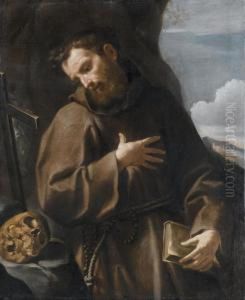Giovan Pietro Zanotti Paintings
Giovan Pietro Zanotti was an Italian painter, art historian, poet, and academic born in 1674 in Bologna, Italy, during the Baroque period, a time characterized by dramatic expression and elaborate ornamentation in art. Zanotti was deeply embedded in the rich cultural and artistic environment of Bologna, which was a significant center for the arts in Italy during his lifetime. He was not only a practitioner of the visual arts but also an important figure in the intellectual circles of his day, contributing significantly to the discourse on art and aesthetics.
Zanotti's artistic training was rooted in the Bolognese tradition, and he was closely associated with the Accademia Clementina, where he held the position of president from 1727 until his death in 1765. His involvement with the Accademia Clementina, an institution dedicated to the advancement and dissemination of the arts and sciences, underscored his commitment to the intellectual and cultural life of Bologna. As a painter, Zanotti's works were reflective of the Baroque style, characterized by dynamic compositions, rich coloration, and a masterful handling of light and shadow, although his oeuvre has not received as much attention as that of his more famous contemporaries.
Beyond his contributions as a painter, Zanotti's legacy is notably marked by his writings on art history and theory. His most significant literary contribution is his biography of the painter Francesco Albani, 'Vita di Francesco Albani,' which remains a valuable source for understanding both the life of Albani and the broader context of Italian Baroque painting. Through his writings, Zanotti provided insights into the artistic milieu of his time, offering perspectives on the aesthetic debates and artistic practices of the 17th and 18th centuries.
Zanotti's multifaceted career as an artist, writer, and academic reflects the interconnectedness of artistic production, intellectual discourse, and cultural patronage in early modern Italy. His works and writings contribute to our understanding of the period's art and its historical context. Giovan Pietro Zanotti passed away in 1765 in Bologna, leaving behind a legacy that encapsulates the vibrancy and complexity of Baroque art and thought.
